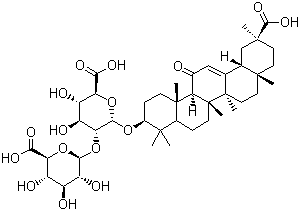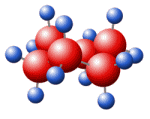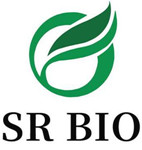|
|
|

|
Suppliers for
Glycyrrhizine
|
Properties | | CAS |
1405-86-3 | | Formula |
C42H62O16 | | EINECS |
215-785-7 |

|
|
5 Registered suppliers
| Appearance | White crystalline powder,odorless,with special sweetness
| | Identification | Positive reaction
| | Assay | ≥ 95%
| | Loss on drying | ≤ 6.0%
| | Residue on ignition | ≤ 0.2%
| | As | ≤ 2PPM
| | Heavy metals | ≤ 20PPM
| | Standard | Technical grade
| | Capacity | 50MT/month
| | Loading port | Shanghai
| | Package | 25kg/drum or according to the customers’ demand
| | Storage | Stored in the dry and ventilated inside storeroom, prevent direct sunlight, slightly pile and put down |
| Appearance | White crystalline powder,odorless,with special sweetness
| | Identification | Positive reaction
| | Assay | ≥ 95%
| | Loss on drying | ≤ 6.0%
| | Residue on ignition | ≤ 0.2%
| | As | ≤ 2PPM
| | Heavy metals | ≤ 20PPM
| | Standard | Technical grade
| | Capacity | 50MT/month
| | Loading port | Shanghai
| | Package | 25kg/drum or according to the customers’ demand
| | Storage | Stored in the dry and ventilated inside storeroom, prevent direct sunlight, slightly pile and put down |
| Appearance | White crystalline powder,odorless,with special sweetness
| | Identification | Positive reaction
| | Assay | ≥ 95%
| | Loss on drying | ≤ 6.0%
| | Residue on ignition | ≤ 0.2%
| | As | ≤ 2PPM
| | Heavy metals | ≤ 20PPM
| | Standard | Technical grade
| | Capacity | 50MT/month
| | Loading port | Shanghai
| | Package | 25kg/drum or according to the customers’ demand
| | Storage | Stored in the dry and ventilated inside storeroom, prevent direct sunlight, slightly pile and put down |
Glycyrrhizic acid is extracted from the roots of the licorice plant; licorice. It is a triterpene glycoside with glycyrrhetinic acid and has a wide range of pharmacological and biological activities. When extracted from plants, it can be obtained in the form of ammonium glycyrrhizinate and monoammonium glycyrrhizinate. Glycyrrhizin has been developed as a liver-protective drug for chronic hepatitis cases in Japan and China. Since January 2014, glycyrrhizic acid as a part of licorice extract has been approved by the FDA as an existing food sweetener. It has been approved by Health Canada for over-the-counter products, but all products are currently in a post-market cancellation status.
Glycyrrhizin is a saponin-like compound that provides licorice (Glycyrrhiza) with the main sweetness and has potential immunomodulatory, anti-inflammatory, liver and neuroprotective and anti-tumor activities. Glycyrrhizin regulates certain enzymes involved in inflammation and oxidative stress, and down-regulates certain pro-inflammatory mediators, thereby preventing inflammation and reactive oxygen species (ROS)-induced damage. Glycerin may also inhibit the growth of susceptible tumor cells.
NCI Thesaurus (NCIt)
A widely used anti-inflammatory agent isolated from licorice root. It is metabolized to glycyrrhetinic acid, which inhibits 11-beta-hydroxysteroid dehydrogenase and other enzymes involved in corticosteroid metabolism. Therefore, glycyrrhizic acid is the main and sweet component of licorice. It has been studied for its ability to cause high-molecular corticosteroid poisoning, accompanied by sodium retention and potassium loss, edema, elevated blood pressure, and renin-angiotensin-aldosterone system. inhibition.
Glycyrrhizic acid is extracted from the roots of the licorice plant; licorice. It is a triterpene glycoside with glycyrrhetinic acid and has a wide range of pharmacological and biological activities. When extracted from plants, it can be obtained in the form of ammonium glycyrrhizinate and monoammonium glycyrrhizinate. Glycyrrhizin has been developed as a liver-protective drug for chronic hepatitis cases in Japan and China. Since January 2014, glycyrrhizic acid as a part of licorice extract has been approved by the FDA as an existing food sweetener. It has been approved by Health Canada for over-the-counter products, but all products are currently in a post-market cancellation status.
Glycyrrhizin is a saponin-like compound that provides licorice (Glycyrrhiza) with the main sweetness and has potential immunomodulatory, anti-inflammatory, liver and neuroprotective and anti-tumor activities. Glycyrrhizin regulates certain enzymes involved in inflammation and oxidative stress, and down-regulates certain pro-inflammatory mediators, thereby preventing inflammation and reactive oxygen species (ROS)-induced damage. Glycerin may also inhibit the growth of susceptible tumor cells.
NCI Thesaurus (NCIt)
A widely used anti-inflammatory agent isolated from licorice root. It is metabolized to glycyrrhetinic acid, which inhibits 11-beta-hydroxysteroid dehydrogenase and other enzymes involved in corticosteroid metabolism. Therefore, glycyrrhizic acid is the main and sweet component of licorice. It has been studied for its ability to cause high-molecular corticosteroid poisoning, accompanied by sodium retention and potassium loss, edema, elevated blood pressure, and renin-angiotensin-aldosterone system. inhibition.
|
Properties:
... more properties and specification on Glycyrrhizine
|
|
Privileged suppliers
Last update 2024-05-13
|



 details
details

